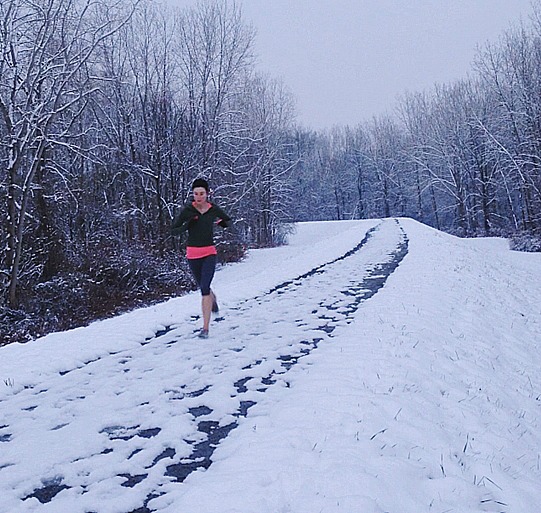A study by Nurse and Nigg found that the sensory threshold of the plantar surface increased in runners under cold conditions. As a result, proprioception was altered in the foot and ankle which decreased loading on the ankle. Therefore, running in cooler temperatures appears to be safe.
Other studies found that ankle, knee and hip-joint loads remained unaltered when runners ran in cold conditions. What does this mean for experienced forefoot runners?
In forefoot running, the feet passively interact with the ground, acting only as platforms to hold the body upright. From a perceptual standpoint, habitual forefoot runners run with ‘less feeling in their feet’ in normal temperatures.

Forefoot running shoes are minimalist that don’t have a lot of insulation, the feet tend to get colder during winter runs.
Luckily, forefoot running is a reflexive adaptation to reduce repetitive stress on the body. If learned correctly and with enough experience, you can pretty much run forefooted without monitoring your mechanics and while your feet are cold.
Because humans are hardwired for forefoot running, cold feet will not profoundly alter mechanics in experienced forefoot runners. In addition, cold feet may block irrelevant stimuli, shutting out sensory chatter in the brain.
Heel Strike vs Forefoot Strike
Other running styles such as heel running may not fare as well as forefoot runners in cooler temperatures. Since heel running involves more controlled manipulation of foot movements during ground contact, heel runners can’t afford to lose ‘any feeling’ in their feet.
Heel running is not reflexively controlled, therefore more conscious effort is needed to power muscle force generation to maintain running. In this case, cold weather can be a mechanical distraction, making it harder for a heel runner to discriminate preferred from non-preferred movements.
As a side note, proprioception that is altered from the cold is different from proprioception that is altered from a thick cushioned running shoe. The body perceives all unnatural cushy surfaces as unstable.
Forefoot running shoes have very minimal cushioning, thus the plantar surface is stable and is perceived by the body as stable despite cold temperatures. Therefore, forefoot runners will not land impulsively when proprioception is altered via coldness and when wearing zero-drop, minimalist shoes.
The take home message is that cold feet does not bring about adverse responses in biomechanics in the experienced forefoot runner mostly because the neural responses that govern a forefoot strike landing are autonomic.
More From Run Forefoot:
- Forefoot Running is Nothing New, Yet It’s Neglected in the Literature
- Find Your Forefoot Running Shoe
- Treating ITBS
- Arch Pain When Running? Forefoot Running Can Help
References:
Nurse, M. A., & Nigg, B. M. (2001). The effect of changes in foot sensation on plantar pressure and muscle activity. Clinical Biomechanics, 16, 719 – 727.
Bretta Riches
BSc Neurobiology; MSc Biomechanics candidate, ultra minimalist runner & founder of RunForefoot. I was a heel striker, always injured. I was inspired by the great Tirunesh Dibaba to try forefoot running. Now, I'm injury free. This is why I launched Run Forefoot, to advocate the health & performance benefits of forefoot running and to raise awareness on the dangers of heel striking, because the world needs to know.
Latest posts by Bretta Riches (see all)
- How to Train Yourself to Not Heel Strike When Running - 24/04/2024
- Cushioned Running Shoes Found to Be Bad for Ankles - 23/04/2024
- Forefoot Running and Achilles Pain - 19/04/2024

Leave a Reply